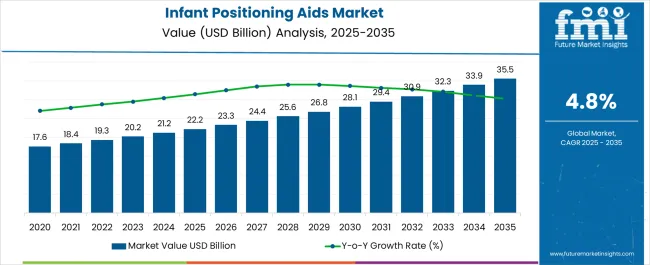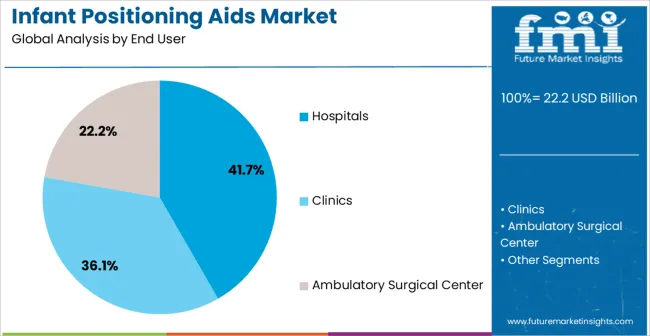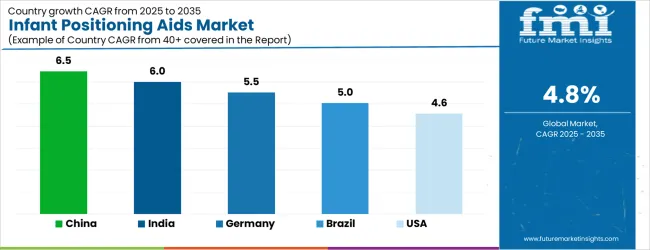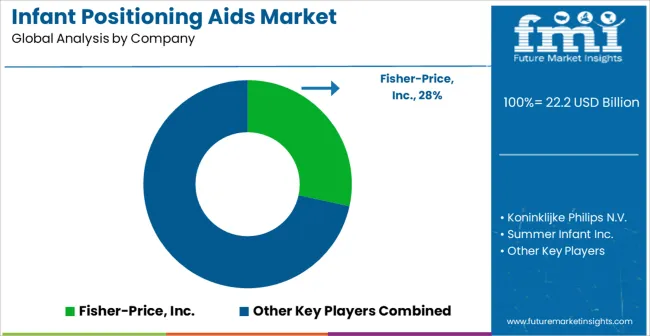The Infant Positioning Aids Market is estimated to be valued at USD 22.2 billion in 2025 and is projected to reach USD 35.5 billion by 2035, registering a compound annual growth rate (CAGR) of 4.8% over the forecast period.

| Metric | Value |
|---|---|
| Infant Positioning Aids Market Estimated Value in (2025 E) | USD 22.2 billion |
| Infant Positioning Aids Market Forecast Value in (2035 F) | USD 35.5 billion |
| Forecast CAGR (2025 to 2035) | 4.8% |
The Infant Positioning Aids market is witnessing notable growth, primarily driven by the rising awareness of neonatal care and the increasing emphasis on improving safety and comfort in healthcare environments. Hospitals and neonatal intensive care units are focusing on advanced aids to reduce complications such as plagiocephaly, respiratory distress, and improper spinal alignment in infants. Growing healthcare investments, particularly in pediatric care, are fueling the demand for specialized positioning devices designed to ensure stable posture and effective clinical outcomes.
Technological advancements are introducing aids that are lightweight, durable, and easy to disinfect, which enhances usability in clinical settings. The market is also benefiting from heightened attention to infection prevention and patient safety standards, as regulatory bodies emphasize improved neonatal care practices.
Furthermore, the rising number of preterm births globally and the growing need for structured neonatal support are increasing adoption rates With parents and healthcare providers seeking reliable, evidence-based solutions to improve infant well-being, the Infant Positioning Aids market is expected to expand steadily, offering innovative designs tailored to meet evolving hospital and clinical requirements.
The infant positioning aids market is segmented by end user, and geographic regions. By end user, infant positioning aids market is divided into Hospitals, Clinics, and Ambulatory Surgical Center. Regionally, the infant positioning aids industry is classified into North America, Latin America, Western Europe, Eastern Europe, Balkan & Baltic Countries, Russia & Belarus, Central Asia, East Asia, South Asia & Pacific, and the Middle East & Africa.

The hospitals segment is expected to account for 41.7% of the Infant Positioning Aids market revenue in 2025, positioning it as the leading end user category. Hospitals dominate due to their extensive focus on neonatal care units and their significant investments in specialized equipment to ensure infant safety and optimal clinical outcomes. These facilities rely on positioning aids to maintain proper alignment, support respiratory function, and reduce the risks associated with prolonged immobilization in preterm and critically ill infants.
The increasing number of neonatal intensive care units worldwide, combined with the growing incidence of preterm births, is accelerating the adoption of these aids. Hospitals are prioritizing high-quality, durable, and easily sanitized positioning aids to align with strict infection control protocols and safety standards.
Additionally, healthcare staff in hospitals are increasingly trained to utilize advanced positioning aids effectively, enhancing patient care and reducing the likelihood of complications As awareness of neonatal well-being continues to rise, hospitals are expected to remain the primary end user, driving demand for advanced infant positioning solutions that combine safety, clinical efficiency, and compliance with global healthcare regulations.
Infant Positioning Aids systems are intended to keep infants intact by using external support in order optimize biomechanical alignment, to enhance sensorimotor experiences, skeletal development and support medical conditions. They are aimed to maintain and improve the autonomic and physiological status of the infants.
Infant positioning aids facilitate flexion in trunk and limbs appropriately for gestational maturation. They facilitate mobility, support self-regulatory behaviors and prevent delays in development. The goal of infant positioning includes not only promoting physiological flexion, but also the prevention of hips external rotation and head flattering.
They are used in the prevention of asymmetrical movement and posture by promoting midline orientation. Traditional infant positioning aids such as boundaries and swaddling's are used to maintain midline orientation and physiological flexion. Swaddlings are used to improve neuromuscular development, improved sleep, decreased startles, improved self-regulation and decrease stress.
Boundaries are used to improve postural and motor behavior development, to decrease abrupt movements and to improve midline movements. Alternatives infant positioning aids are designed to allow movement of extremities along with containment of the infant.

| Country | CAGR |
|---|---|
| China | 6.5% |
| India | 6.0% |
| Germany | 5.5% |
| Brazil | 5.0% |
| USA | 4.6% |
| UK | 4.1% |
| Japan | 3.6% |
The Infant Positioning Aids Market is expected to register a CAGR of 4.8% during the forecast period, exhibiting varied country level momentum. China leads with the highest CAGR of 6.5%, followed by India at 6.0%. Developed markets such as Germany, France, and the UK continue to expand steadily, while the USA is likely to grow at consistent rates. Japan posts the lowest CAGR at 3.6%, yet still underscores a broadly positive trajectory for the global Infant Positioning Aids Market. In 2024, Germany held a dominant revenue in the Western Europe market and is expected to grow with a CAGR of 5.5%. The USA Infant Positioning Aids Market is estimated to be valued at USD 8.4 billion in 2025 and is anticipated to reach a valuation of USD 8.4 billion by 2035. Sales are projected to rise at a CAGR of 0.0% over the forecast period between 2025 and 2035. While Japan and South Korea markets are estimated to be valued at USD 1.2 billion and USD 640.3 million respectively in 2025.

| Item | Value |
|---|---|
| Quantitative Units | USD 22.2 Billion |
| End User | Hospitals, Clinics, and Ambulatory Surgical Center |
| Regions Covered | North America, Europe, Asia-Pacific, Latin America, Middle East & Africa |
| Country Covered | United States, Canada, Germany, France, United Kingdom, China, Japan, India, Brazil, South Africa |
| Key Companies Profiled | Fisher-Price, Inc., Koninklijke Philips N.V., Summer Infant Inc., Baby Delight Inc., and Leachco, Inc. |
The global infant positioning aids market is estimated to be valued at USD 22.2 billion in 2025.
The market size for the infant positioning aids market is projected to reach USD 35.5 billion by 2035.
The infant positioning aids market is expected to grow at a 4.8% CAGR between 2025 and 2035.
The key product types in infant positioning aids market are hospitals, clinics and ambulatory surgical center.
In terms of , segment to command 0.0% share in the infant positioning aids market in 2025.






Our Research Products

The "Full Research Suite" delivers actionable market intel, deep dives on markets or technologies, so clients act faster, cut risk, and unlock growth.

The Leaderboard benchmarks and ranks top vendors, classifying them as Established Leaders, Leading Challengers, or Disruptors & Challengers.

Locates where complements amplify value and substitutes erode it, forecasting net impact by horizon

We deliver granular, decision-grade intel: market sizing, 5-year forecasts, pricing, adoption, usage, revenue, and operational KPIs—plus competitor tracking, regulation, and value chains—across 60 countries broadly.

Spot the shifts before they hit your P&L. We track inflection points, adoption curves, pricing moves, and ecosystem plays to show where demand is heading, why it is changing, and what to do next across high-growth markets and disruptive tech

Real-time reads of user behavior. We track shifting priorities, perceptions of today’s and next-gen services, and provider experience, then pace how fast tech moves from trial to adoption, blending buyer, consumer, and channel inputs with social signals (#WhySwitch, #UX).

Partner with our analyst team to build a custom report designed around your business priorities. From analysing market trends to assessing competitors or crafting bespoke datasets, we tailor insights to your needs.
Supplier Intelligence
Discovery & Profiling
Capacity & Footprint
Performance & Risk
Compliance & Governance
Commercial Readiness
Who Supplies Whom
Scorecards & Shortlists
Playbooks & Docs
Category Intelligence
Definition & Scope
Demand & Use Cases
Cost Drivers
Market Structure
Supply Chain Map
Trade & Policy
Operating Norms
Deliverables
Buyer Intelligence
Account Basics
Spend & Scope
Procurement Model
Vendor Requirements
Terms & Policies
Entry Strategy
Pain Points & Triggers
Outputs
Pricing Analysis
Benchmarks
Trends
Should-Cost
Indexation
Landed Cost
Commercial Terms
Deliverables
Brand Analysis
Positioning & Value Prop
Share & Presence
Customer Evidence
Go-to-Market
Digital & Reputation
Compliance & Trust
KPIs & Gaps
Outputs
Full Research Suite comprises of:
Market outlook & trends analysis
Interviews & case studies
Strategic recommendations
Vendor profiles & capabilities analysis
5-year forecasts
8 regions and 60+ country-level data splits
Market segment data splits
12 months of continuous data updates
DELIVERED AS:
PDF EXCEL ONLINE
Infant Incubators & Warmers Market Size and Share Forecast Outlook 2025 to 2035
Infant Nutrition Hydrolysate Ingredients Market Size and Share Forecast Outlook 2025 to 2035
Infant Formula DHA Algae Oil Market Size and Share Forecast Outlook 2025 to 2035
Infant Fever Stickers Market Size and Share Forecast Outlook 2025 to 2035
Infant Nutritional Premix Market Size and Share Forecast Outlook 2025 to 2035
Infant Incubators Market Analysis - Trends & Forecast 2025 to 2035
Infant Formula Industry Analysis in United States Analysis - Size, Share, and Forecast Outlook 2025 to 2035
Infant Formula Market Analysis - Size, Share, and Forecast Outlook 2025 to 2035
AIDS Related Primary CNS Lymphoma Market Report – Growth & Forecast 2025 to 2035
Infant Formula Ingredients Market Analysis - Size, Share & Forecast 2025 to 2035
Infant Care Equipment Market Growth - Trends & Forecast 2025 to 2035
Repositioning and Offloading Market – Trends & Forecast 2024 to 2034
Repositioning & Offloading Devices Market – Demand & Forecast 2024 to 2034
A2 Infant Formula Market Analysis By Form Type, By Age Group, By Distribution Channel and By Region - Forecast from 2025 to 2035
X-Ray Positioning Devices Market Size and Share Forecast Outlook 2025 to 2035
Spine Positioning Devices Market
Global Positioning Systems Market Size and Share Forecast Outlook 2025 to 2035
Hearing Aids Market Forecast and Outlook 2025 to 2035
Dynamic Positioning System Market Size and Share Forecast Outlook 2025 to 2035
Patient Positioning Equipment Market Size and Share Forecast Outlook 2025 to 2035

Thank you!
You will receive an email from our Business Development Manager. Please be sure to check your SPAM/JUNK folder too.
Chat With
MaRIA